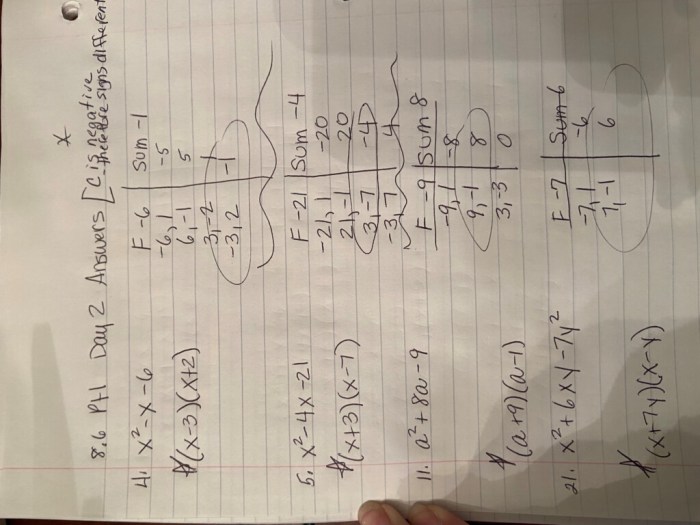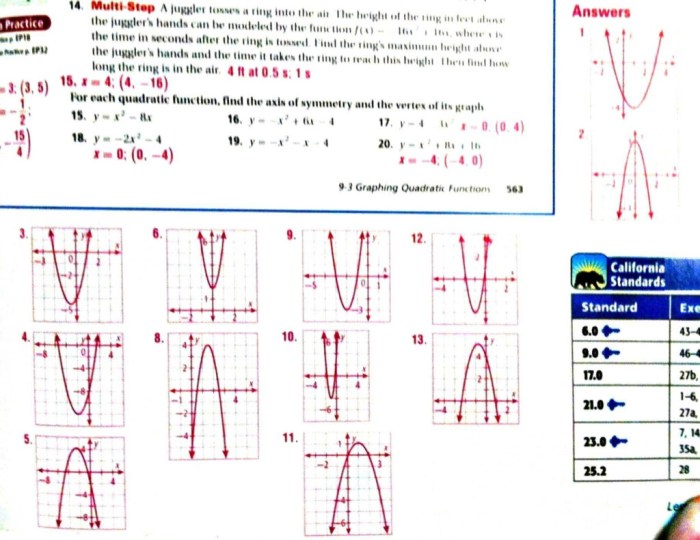Welcome to the realm of quadratic functions, where the attributes of quadratic functions worksheet will guide us through a fascinating exploration of their key characteristics, graphing techniques, and real-world applications. Brace yourself for an in-depth understanding of these parabolic wonders.
In this comprehensive worksheet, we will delve into the defining attributes of quadratic functions, such as their vertex, axis of symmetry, and intercepts. We will also explore the art of graphing quadratic functions using various forms and uncover the profound relationship between their attributes and their graphical representations.
Attributes of Quadratic Functions

Quadratic functions, also known as second-degree polynomials, are functions of the form f(x) = ax² + bx + c, where a, b, and c are real numbers and a ≠ 0. The key attributes of quadratic functions include the vertex, axis of symmetry, and intercepts.
The vertex of a quadratic function is the point where the graph of the function changes direction. The x-coordinate of the vertex is given by x = -b/2a, and the y-coordinate is given by f(-b/2a). The axis of symmetry is the vertical line that passes through the vertex.
The equation of the axis of symmetry is x = -b/2a.
The intercepts of a quadratic function are the points where the graph of the function intersects the x-axis and y-axis. The x-intercepts are found by solving the equation f(x) = 0, and the y-intercept is found by evaluating f(0).
For example, consider the quadratic function f(x) = x² – 4x + 3. The vertex of this function is at the point (2, -1), the axis of symmetry is the vertical line x = 2, and the x-intercepts are at the points (1, 0) and (3, 0).
Graphing Quadratic Functions
Quadratic functions can be graphed using the vertex form, factored form, or standard form.
The vertex form of a quadratic function is f(x) = a(x – h)² + k, where (h, k) is the vertex of the function. To graph a quadratic function in vertex form, plot the vertex and then use the slope of the function to draw the rest of the graph.
The factored form of a quadratic function is f(x) = a(x – r)(x – s), where r and s are the roots of the function. To graph a quadratic function in factored form, plot the roots and then use the slope of the function to draw the rest of the graph.
The standard form of a quadratic function is f(x) = ax² + bx + c. To graph a quadratic function in standard form, use the following steps:
- Find the vertex of the function.
- Find the intercepts of the function.
- Plot the vertex and intercepts.
- Use the slope of the function to draw the rest of the graph.
Solving Quadratic Equations, Attributes of quadratic functions worksheet
Quadratic equations can be solved using a variety of methods, including factoring, completing the square, and using the quadratic formula.
To solve a quadratic equation by factoring, factor the left-hand side of the equation and then set each factor equal to zero. Solve each resulting linear equation to find the roots of the quadratic equation.
To solve a quadratic equation by completing the square, add and subtract the square of half the coefficient of the x-term to the left-hand side of the equation. Then factor the left-hand side of the equation and solve each resulting linear equation to find the roots of the quadratic equation.
To solve a quadratic equation using the quadratic formula, use the following formula:
x = (-b ± √(b²
4ac)) / 2a
where a, b, and c are the coefficients of the quadratic equation.
Applications of Quadratic Functions
Quadratic functions have a wide range of applications in the real world, including projectile motion, parabolic trajectories, and optimization problems.
In projectile motion, the height of a projectile is given by a quadratic function of time. The vertex of the function represents the maximum height of the projectile, and the axis of symmetry represents the time at which the projectile reaches its maximum height.
In parabolic trajectories, the path of a projectile is given by a quadratic function. The vertex of the function represents the highest point of the trajectory, and the axis of symmetry represents the line of symmetry of the trajectory.
In optimization problems, quadratic functions can be used to find the maximum or minimum value of a function. The vertex of the function represents the maximum or minimum value of the function.
FAQ Explained: Attributes Of Quadratic Functions Worksheet
What is the vertex of a quadratic function?
The vertex of a quadratic function is the point where the function changes direction, either from increasing to decreasing or vice versa. It is the highest or lowest point on the parabola.
How do you find the axis of symmetry of a quadratic function?
The axis of symmetry of a quadratic function is a vertical line that divides the parabola into two symmetrical halves. It is given by the equation x = -b/2a.
What are the intercepts of a quadratic function?
The intercepts of a quadratic function are the points where the graph of the function crosses the x- and y-axes. The x-intercepts are found by setting y = 0 and solving for x, while the y-intercept is found by setting x = 0 and solving for y.
